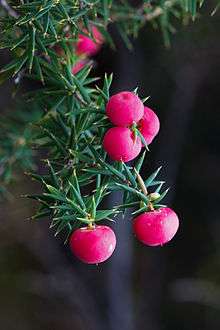എറിക്കേസീ
ഒരു ദ്വിബീജപത്രക് സസ്യകുടുംബമാണ് എറിക്കേസീ (Ericaceae). മുഖ്യമായും ആസ്ട്രേലിയയിലാണ് ഈ കുടുംബത്തിൽപ്പെട്ട സസ്യങ്ങൾ കണ്ടുവരുന്നത്. ഏകദേശം 23 ജീനസുകളും 350 സ്പീഷീസുകളും ഇത് ഉൾക്കൊള്ളുന്നു ഇന്ത്യയിലും തെക്കേ അമേരിക്കയിലും ഈ സസ്യകുടുംബത്തിൽപ്പെട്ട ചില ചെടികൾ വളരുന്നുണ്ട്.[1] സ്റ്റൈഫീലിയ (175 സ്പീഷീസ്), എപാക്രിസ് (34 സ്പീഷീസ്) എന്നിവയാണ് ഏറ്റവും വലിയ ജീനസുകൾ. പ്രിയോനോട്സ് (Prionotes), ലെബെറ്റാന്തസ് (Lebetanthus) എന്നീ ജീനസുകളിൽ ഓരോ സ്പീഷീസ് വീതമേയുള്ളു.[2][3]
| എറിക്കേസീ | |
|---|---|
 | |
| എറിക്കേസീ | |
| Scientific classification | |
| Kingdom: | Plantae |
| (unranked): | Angiosperms |
| (unranked): | Eudicots |
| (unranked): | Asterids |
| Order: | Ericales |
| Family: | Ericaceae Juss. |
| Genera | |
|
See text. | |
എപാക്രിഡേസി കുടുബാംഗങ്ങൾ ചെറിയ കുറ്റിച്ചെടികളാണ്. ചെറുതും വീതികുറഞ്ഞു കട്ടിയുള്ളതുമായ ഇലകൾ സാധാരണയായി ഏകാന്തരമായി ക്രമീകരിച്ചിരിക്കുന്നു. പൂക്കൾ ദ്വിലിംഗി (bisexual) കളും സമമിത (regular) ങ്ങളുമാണ്. മണിയുടെ ആകൃതിയിൽ ഒറ്റയായി കാണപ്പെടുന്ന പൂക്കൾ സൗരഭ്യമുള്ളവയാണ്. പൂക്കൾക്കു സഹപത്ര (bract) വും സഹപത്രക (bracteole) വും ഉണ്ടായിരിക്കും. ബാഹ്യദളങ്ങൾ സ്വതന്ത്രങ്ങളാണ്. കുഴലുപോലെ കാണുന്ന ദളപുടം അഞ്ചു ദളങ്ങൾ ചേർന്നുണ്ടായിരിക്കുന്നു. അഞ്ചു കേസരങ്ങൾ ദളപുടത്തിലെ ഇതളുകൾക്ക് ഏകാന്തരമായി (alternate) സ്ഥിതിചെയ്യുന്നു. ദളങ്ങൾ ചേർന്നുണ്ടായ കുഴലിന്റെ മുകൾഭാഗത്താണ് സാധാരണയായി ഇവ കാണപ്പെടുന്നത്. ചിലപ്പോൾ ഒന്നിടവിട്ട് വന്ധ്യകേസരങ്ങൾ ഉണ്ടായിരിക്കും. പൊട്ടുന്ന സമയമാകുമ്പോഴേക്കും അന്ഥറിലെ രണ്ട് അറകൾ ചേർന്ന് ഒറ്റ അറയായിത്തീരുന്നു. അണ്ടാശയം ഊർധ്വവർത്തി (superior) ആണ്. ദളങ്ങൾക്ക് അഭിമുഖമായി അഞ്ച് അണ്ഡ്പർണ (carpel) ങ്ങൾ സ്ഥിതിചെയ്യുന്നു. എപാക്രീസ് ഉൾപ്പെടെയുള്ള പകുതിയോളം ജീനസുകളിലും നിരവധി വിത്തുകളുള്ള സമ്പുടഫലമാണു കാണാറുള്ളത്. ഓരോ അറയിലും ഓരോ ബിജാണ്ഡം മാത്രമുള്ള ശേഷിക്കുന്ന ജീനസുകളിൽ സരസഫല (berry) മോ അമ്രക (drupe) മോ ആയിരിക്കും. വിത്തിനുള്ളിൽ ധാരാളം ബിജാന്നമുണ്ട്.[4]
ബ്രിട്ടനിലെ ഗ്രീൻ ഹൗസുകളിൽ ഈ കുലത്തിൽപ്പെടുന്ന പല ചെടികളെയും വളർത്തി വരുന്നു. എപാക്രിസ്ലോൻജിഫോളിയാ എന്ന ചെടിയിലെ ശോണവർണമുള്ള പൂക്കളും എപാഒബ്റ്റ്യൂസിഫോളിയാ യിലെ മഞ്ഞപൂക്കളും അത്യധികം ഭംഗിയും സൗരഭ്യവുമുള്ളവയാണ്. ഇതിൽപ്പെട്ട ചില സസ്യങ്ങളുടെ കായ്കൾ ഭക്ഷ്യയോഗ്യമാണ്.
ഇതും കാണുക
In 2002, systematic research resulted in the inclusion of the formerly recognised families Empetraceae, Epacridaceae, Monotropaceae, Prionotaceae, and Pyrolaceae into the Ericaceae based on a combination of molecular, morphological, anatomical, and embryological data, analysed within a phylogenetic framework.[5] The move significantly increased the morphological and geographical range found within the group. One possible classification of the resulting family includes 9 subfamilies, 126 genera, and about 4000 species:[6]
- Enkianthoideae Kron, Judd & Anderberg (one genus, 16 species)
- Pyroloideae Kosteltsky (4 genera, 40 species)
- Monotropoideae Arnott (10 genera, 15 species)
- Arbutoideae Niedenzu (up to six genera, about 80 species)
- Cassiopoideae Kron & Judd (one genus, 12 species)
- Ericoideae Link (19 genera, 1790 species)
- Harrimanelloideae Kron & Judd (one genus, two species)
- Styphelioideae Sweet (35 genera, 545 species)
- Vaccinioideae Arnott (50 genera, 1580 species)
അവലംബം
- http://www.meemelink.com/prints%20pages/prints.Epacridaceae.htm Epacridaceae
- http://asgap.org.au/b-pri.html Banksia prionotes
- http://florabase.dec.wa.gov.au/browse/profile/1842 Banksia prionotes Lindl
- EPACRIDACEAE CHARACTERISTICS OF COMMON DICOT. FAMILIES